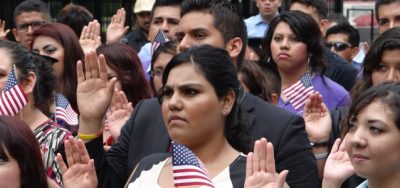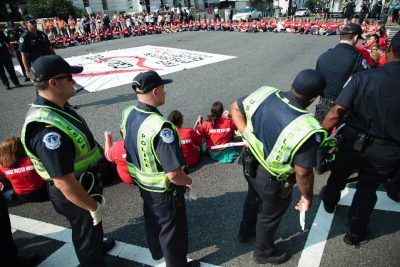Legislation

House Democrats Unveil Comprehensive Immigration Reform Proposal
Washington D.C. – Today, in an important effort to keep the conversation and momentum on immigration reform moving forward in the House, a group of centrist Democrats introduced their version of the Border Security, Economic Opportunity, and Immigration Modernization Act. Although the full text has not yet been made available,… Read More

The California Domestic Workers Bill of Rights Speaks to the Need for Wise Immigration Reform
On September 26, Gov. Jerry Brown signed into law the California Domestic Workers Bill of Rights (AB241). Only the third state-level measure of its kind in the country after New York and Hawaii passed their own bills, the Bill of Rights represents an historic milestone for domestic workers and advocacy groups seeking social justice for one of our most vulnerable—yet vital—workforces. The victory is also a triumph of the immigrant rights movement in securing basic labor protections for a group of individuals—in particular, immigrant women—who are often isolated and at risk for multiple forms of exploitation. Read More

How a Government Shutdown Likely Affects Immigration Agencies
The government’s fiscal year ends today, and without legislation authorizing spending to continue, whether for the full fiscal year or even a few weeks, many federal offices and services will be shuttered starting tomorrow. Unfortunately, the chances the United States government will avoid a shutdown are low. The Senate has tabled the House-approved spending bill, which defunds the Affordable Care Act, and sent it back to the House, but it is unlikely that a consensus will be found before the midnight deadline. This means that beginning Tuesday, an estimated 800,000 to 1 million federal employees will be furloughed and government offices and national parks will close. Details of the impact of the shutdown are emerging and the situation is fluid, but based on what we do know and what happened the last time the federal government shut down in 1996, here is what likely will happen: Read More

College Leaders Know Immigration Reform Will Help Their Students and the Country
The U.S. has long been a destination for students around the world. They come to attend the nation’s colleges and universities, and many wish to stay to pursue job opportunities and make their lives here, but our immigration system throws up barriers at every step of the way. Foreign students add billions of dollars to the U.S. economy each year, and those who remain are more likely to start businesses and contribute to innovation than their American counterparts. Right now, as the economy struggles back to life, it’s hard to imagine letting such opportunities go to waste. Growing frustration with this dilemma is leading more and more college presidents, professors, and higher education administrators across the country to declare their support for improving the nation’s immigration policies. Read More

Dollars and Lives Lost in the Wait for Immigration Reform
Two-and-a-half months after the Senate passed immigration reform legislation (S. 744), the House of Representatives continues to dawdle. Other than giving speeches and mulling over a few backward-looking, enforcement-only bills, the House has done nothing to revamp the broken U.S. immigration system or to realistically resolve the status of the 11 million unauthorized immigrants now living in the United States. The standard excuse for this inaction is that there are too many other high-priority items on the legislative agenda right now—so immigration reform will have to wait. But while Congress waits, dollars and lives are being lost. Read More

Months After Passage, Anti-Immigrant Group Still Mischaracterizes Senate Bill
The immigration reform bill (S.744) that the Senate passed in June would fix our broken work visa programs for lower skilled, higher skilled, and agricultural workers; eliminate decades-long backlogs in our immigrant visa programs; increase job and wage protections for U.S. workers; and greatly increase our investment in border security. In addition, the bill would have fiscal and economic effects that would be overwhelmingly positive, according to the Congressional Budget Office (CBO). If enacted, the bill would help reduce the federal budget deficit by approximately $1 trillion over 20 years, would boost the U.S. economy as whole without negatively affecting U.S. workers, and would greatly reduce future undocumented immigration, according to the CBO. However, the Federation for American Immigration Reform (FAIR) released a report this week criticizing the bill. They claim S.744 offers an immediate “amnesty” for the undocumented, lacks specific metrics for measuring border enforcement, weakens the visa entry-exit system, and creates a “nebulous new system” that fails to protect Americans from illegal foreign workers. Read More

White House Honors Local Groups Leading the Way to Welcome Immigrants in Their Cities
Thousands of immigrants every day demonstrate a commitment to being part of America by becoming naturalized citizens every day. These Americans by choice often make huge sacrifices to move to the United State and become part of their community. But it also takes support from the local community to welcome new immigrants who want to establish roots in the area. Groups across the country are stepping up to fill that role and make their cities inviting to immigrants. Read More

Immigration is a Positive Force for Economic Growth in Cities
Posters on metro buses and trains in St. Louis will now welcome you to the city in 17 different languages, one of the many initiatives begun by the St. Louis Mosaic Project to create an atmosphere that welcomes and encourages immigrants to the area. Signs in the public transit system aren’t just designed to look pretty, however, but acknowledge that for many immigrants, particularly those new to the St. Louis region, this is their primary means of going to work or school, shopping, and taking part in all the community has to offer. “The Mosaic Project says a lot about where our region is going,” St. Louis County Executive Charlie Dooley said. “We want to be more diverse and see things from different points of view.” Read More

Taking the Important Leap to Citizenship
Each year on September 17, the United States observes Constitution Day and Citizenship Day, a combined event that commemorates the anniversary of the nation’s constitution and recognizes all those who are or have become U.S. citizens. It is considered a time for Americans to reflect on the importance of the rights and responsibilities of citizenship, as well as what it means to be a U.S. citizen. However, it’s also an important time to applaud those who have worked hard to become citizens, while exploring ways to remove barriers for those who are eligible, but still haven’t taken the leap. Read More

Women Arrested Demand Action on Immigration Reform
More than 100 women blocked an intersection outside of the House of Representatives Thursday to push for House leaders to finally act on immigration reform. Capitol Police officers arrested the 104 women, including more than 20 who are undocumented, for the act of civil disobedience. More than 200 supporters witnessed the arrests and called on the House to match the women’s courage and pass legislation that will fix the U.S. immigration system. “Each one of us here today understands what incredibly high stakes we are talking about—immigration reform is not just a piece of legislation but the ability for us to take care of our families,” said Pramila Jayapal, co-chair of We Belong Together: Women for Common-Sense Immigration Campaign, at a rally before the arrests. Read More
Make a contribution
Make a direct impact on the lives of immigrants.
